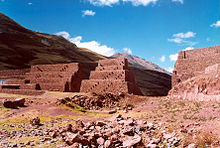


View of Rumicolca
| |
|
Shown within Peru | |
| Location | Lucre District, Quispicanchi Province, Cusco Region, Peru |
|---|---|
| Region | Andes |
| Coordinates | 13°37′05″S 71°42′26″W / 13.61806°S 71.70722°W / -13.61806; -71.70722 |
Rumicolca[1][2] (possibly from Quechua rumi stone, qullqa, qulqa deposit, storehouse)[3] is an archaeological site in Peru. It is located in the Cusco Region, Quispicanchi Province, Lucre District. Rumicolca is situated near the archaeological sites Chuqi Pukyu and Pikillaqta, east of Lake Huacarpay.
Folklore
The Gate Theory
The Aqueduct Theory

High resolution panorama of Rumicolca taken in 2012: https://www.gigapan.com/gigapans/226566